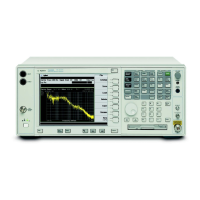286 Chapter 5
Concepts
Tuned RF Level Measurement Concepts
Tuned RF Level Measurement Concepts
Purpose
Unlike RF Power measurements which measure total power across a wide
frequency band, Tuned RF Level measurements tune to the frequency in interest
and are capable of measuring extremely low levels of power. This is particularly
useful when a step attenuator or a signal generator is tested for step accuracy of
power output with incremental changes.
The Measuring Receiver System can accurately measure the absolute or relative
power of low level, continuous wave (CW), RF signals. At each measurement
frequency, the instrument must be calibrated to correct for frequency-dependent
measurement variations.
Calibration over the full dynamic range requires calibration at three different
levels. The calibration remains valid for any CW signal at that frequency +/- 5%
(or above 100 MHz +/- 5 MHz, whichever is smaller).
Measurement Technique
Two ways of making ranging calibration are supported: automatic ranging
calibration and manual ranging calibration, which have different calibration
procedures.
1. Automatic ranging calibration
With automatic ranging calibration, the Measuring Receiver can make
automatic ranging calibration without manual intervention. The Measuring
Receiver will perform ranging calibration automatically depending on the SNR
of input RF signal; if SNR is lower than 35 dB, the Measuring Receiver will
perform a range-to-range calibration.
2. Manual ranging calibration
With manual ranging calibration, the Measuring Receiver performs ranging
calibration with manual intervention manually, depending on the input RF
signal level and the signal frequency. If the power of the signal of interest is
close to a range calibration level, the Measuring Receiver will perform a
range-to-range calibration by displaying the “Recal” indicator. The calibration
must be initiated by pressing
TRFL Cal.
Power Calibration
An initial absolute power level calibration is made by applying a signal to the
Measuring Receiver via a calibrated sensor module. The signal must be within
both the sensor module’s and Measuring Receiver’s power and frequency range.
The absolute power is first measured by Power Meter and stored as the reference
level. Then PSA makes a power measurement at the same frequency. The input
signal level must not change during this re-calibration. The signal level must be
